Santa Fe, New Mexico is a majestic and quirky city in the so-called “Land of Enchantment” that is famous for, among other things, its rugged desert beauty, the area’s robust artistic legacy, stellar intersectional culture, and lovely, multiethnic, Southwestern-style food.
The landscape of this unique region of the United States famously inspired the work of artist Georgia O’Keeffe, who was in awe of the red-and-purple mesa mountaintops and turquoise skies that would come to feature prominently in her paintings.
The unique botany of the landscape– from willowy cottonwood to fragrant juniper and indigenous piñon pines– also creates an indelible impression in the mind.
Today, Santa Fe’s intrigue and beauty persist both in O’Keeffe’s paintings and in the memories of anyone who has ever visited here. It’s an enduringly mystical place.
The desert encompassing Santa Fe, moreover, invites both mystery and wonder. The arid climes and glittering Chama River add oasis-like splendor to this unique, arroyo-scarred landscape, which is why this bespoke Santa Fe Travel guide pays particular attention to local culture, local foods, and local artisan and craft traditions that are intimately inspired by the environment and it’s people.
Below, we spotlight the best things to eat, see, explore, discover, hike, buy, and do in Santa Fe, New Mexico. But first, here are some housekeeping details you should know:
- First, when traveling to Santa Fe, be sure to bring sunglasses, sunscreen, and a hat. The sun is very intense in the desert any time of year!
- Second, the Santa Fe Regional Airport is very small, which means that flying here typically requires transferring on a small flight from a bigger airport hub like Dallas, or Phoenix, etc. If you don’t like small planes, consider flying to nearby Albuquerque International Sunport and driving. (It’s only 1 hour from Santa Fe.)
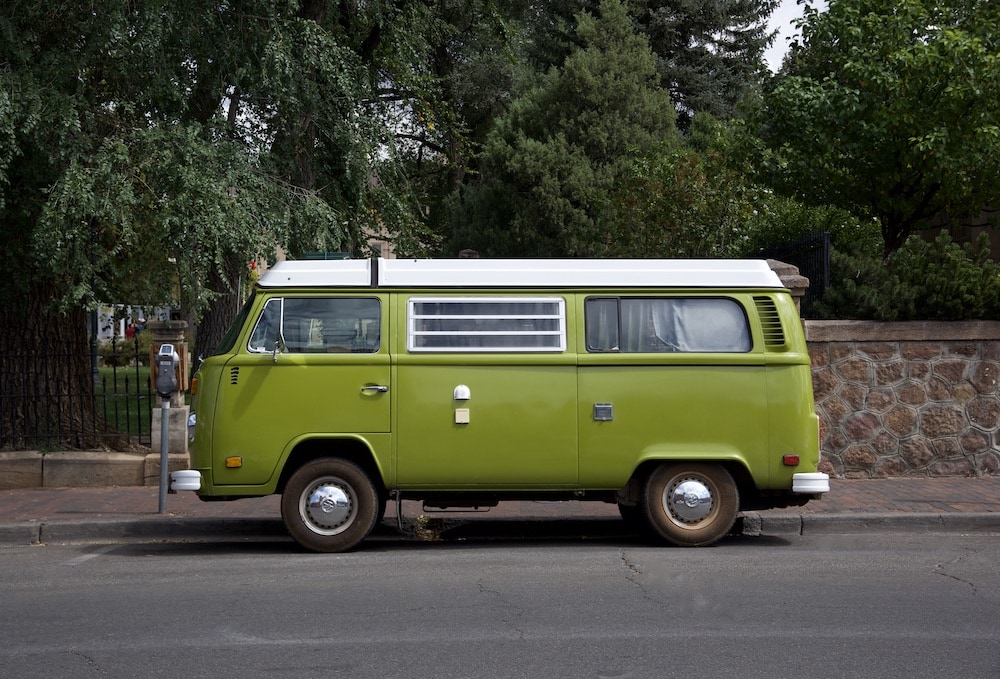
Also, climate plays a huge role in everyone’s experience of Santa Fe.
September is the best time of year to visit Santa Fe, New Mexico. (But be sure to bring layers of clothing no matter when you visit, as temperatures in the desert can fluctuate wildly between day and night. This is true any time of year.)
For the best weather experience in Santa Fe, moreover (e.g. if you want to visit when it isn’t too hot or too cold), we also recommend planning your trip during the region’s two peak seasons. These are late Spring (aka April-June) or early Fall (September-October).
^ Trust me on the timing here. Perfect weather will make your experience in “The Land of Enchantment” even more magical.
Below, we spotlight the best things to do in Santa Fe, New Mexico. Bookmark this guide for easy reference later.
Enjoy your trip!
***
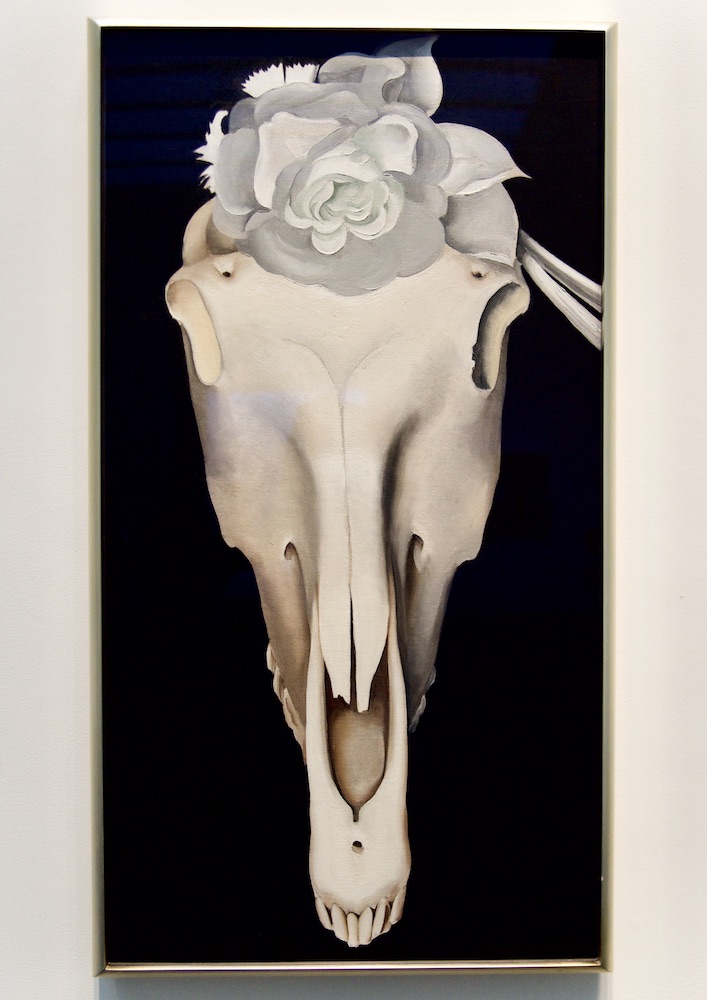
Visit The Georgia O’Keeffe Museum
The Georgia O’Keeffe Museum in downtown Santa Fe is delightful, which is why it’s an essential stop for any visitor to Santa Fe– especially art-lovers. Take in some of the artist’s most iconic works in this tightly-curated collection, which traces a chronology of O’Keeffe’s life and legacy with gleeful aplomb.
Throughout the museum, visitors can watch archival footage of the artist and read intimate reflections on her life, her artistic philosophy, and her muse-like love affair with the grandeur of the region.
“[New Mexico] is the most wonderful place you can imagine. It’s so beautiful there. It’s ridiculous.”
— Georgia O’Keeffe, 1945
The Georgia O’Keeffe Museum also provides context for the greater development of American modernism, as well as O’Keeffe’s role in pioneering the genre not just for the culture, but for female artists in particular.
For what it’s worth, the museum gift shop is also lovely. They have great stuff– silk scarves, gorgeous postcards, and other artistic paraphernalia. Be sure to stop by before you leave!
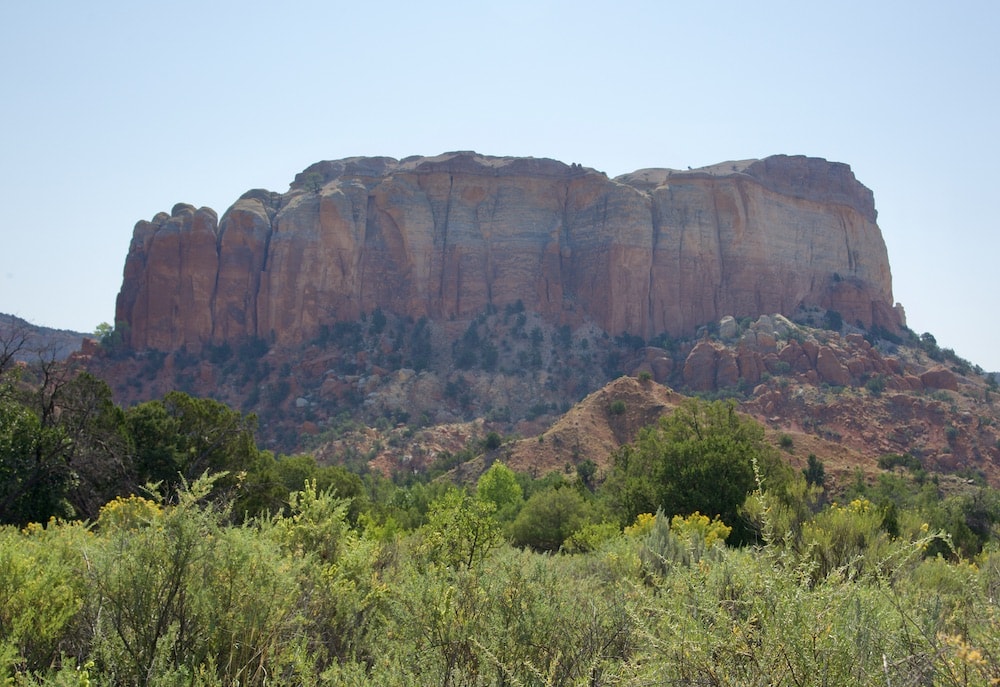
Explore The Jaw-Dropping Landscape of Ghost Ranch
Those with even a remote interest in Georgia O’Keeffe must make the obligatory trip out to Abiquiu, New Mexico to visit Ghost Ranch, the working ranch that inspired O’Keeffe’s most iconic paintings of the American Southwest.
Nestled amidst the Sangre de Christo mountain range in Abiquiu, New Mexico, the ranch is about an hour’s drive north of Santa Fe, not too far from Ojo Caliente Mineral Springs. (More on that charming oasis, below.) The landscape, moreover, is absolutely gorgeous here.
Ghost Ranch is a sprawling ranch with on-site lodging that offers scenic tours, hiking, horseback riding, and sunset trail rides out to the locations that inspired O’Keeffe’s most iconic works.
Many famous movies were also filmed here over the years, including Indiana Jones, City Slickers, and Cowboys and Aliens.
Ideally, take a walking tour or hike along the Chinle formation to get a view of Pedernal, the purple table mountain that features prominently in Georgia O’Keeffe’s paintings. (Her ashes were scattered at the top when she died.)
Or, hike the Box Canyon Trail, an easy out-and-back that gives you access to great views, accessible terrain, and intriguing local flora like pinon pines, juniper, brushy cottonwood, willow, and Ponderosa pine. For plant lovers, there are a lot of subtle, wonderful details.
Then, visit the museum shop for more quirky insight into the Hollywood history and paleontology of this scenic former dude ranch. These 21,000 acres feature everything from Triassic dinosaur fossils to rock shelter sites that date back 8,000 years!
On your way back to Santa Fe, you can also swing by Georgia O’Keeffe’s former house and studio, which is also located in Abiquiu. (More on that, below.)
Advanced reservations for all tours are required. Plan your visit to Ghost Ranch here.
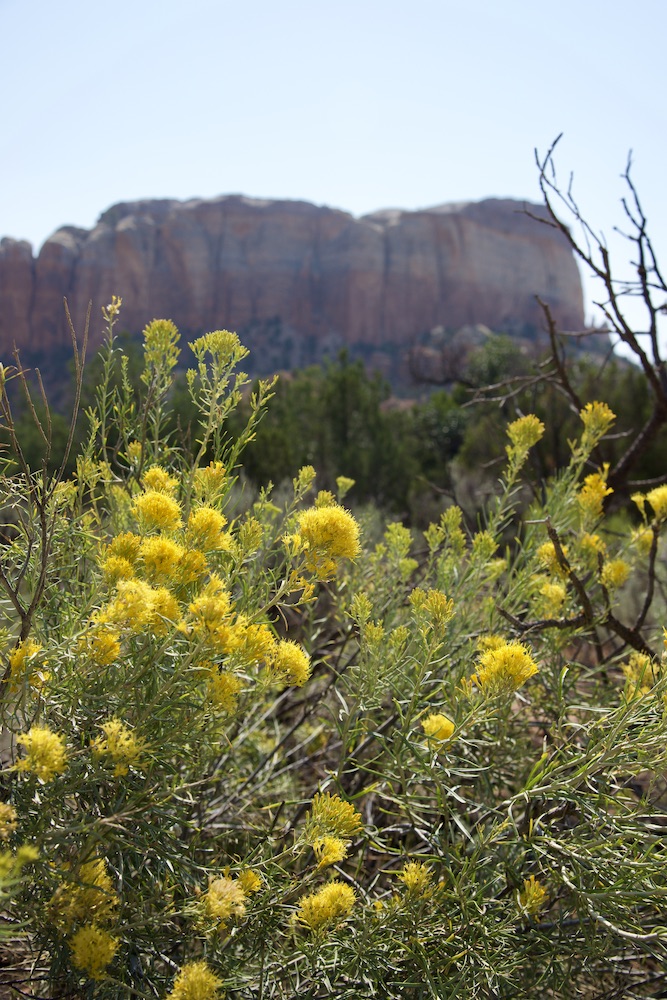
Visit O’Keeffe’s Abiquiu Home + Studio Tour
Georgia O’Keeffe’s Abiquiu Home + Studio tour offers additional insight into the stunning Northern New Mexico landscape that so captivated the artist. Visits to the site are organized by the Georgia O’Keeffe Museum. They offer special behind-the-scenes tours and photography tours, as well.
Here, you can explore O’Keeffe’s own garden and the studio where she painted some of her most iconic works.
Get to know what she grew and harvested in her own kitchen. See where she painted. Take in the vast desert landscape beyond the gates.
You might even recognize some scenes from the artist’s paintings– especially if the light is hitting just right. For a certain kind of art lover, this experience of O’Keeffe’s one-time living quarters is about as transporting as it gets.

Soak at Ojo Caliente Ancient Mineral Springs
No trip to New Mexico would be complete without experiencing the sacred healing waters of Ojo Caliente, which is about 1-hour north of Santa Fe.
These ancient mineral springs at Ojo Caliente Resort & Spa are among the best in the world– literally. (The natural hots springs was recently ranked No. #4 in Travel + Leisure‘s Top 10 Destination Spas in the U.S..)
In 2018, the spa celebrated its 150th anniversary. It’s now one of the oldest natural health resorts in America, as it originally opened in 1868!
People adore this relaxing, transporting 1,100-acre desert oasis, which has been honored by Native Americans for thousands of years.
The legendary waters at Ojo are the only hot springs in the world that feature a remarkable combination of four different sulfur-free mineral waters: an Iron spring, an Arsenic spring, a Lithia spring, and a Soda spring. They also have a Kiva Pool that features a combination of iron and arsenic mineral waters.
-
Serene, Healing Waters + A Lovely Spa
Each mineral spring offers a range of different health benefits.
The Iron soak boosts immunity and prevents fatigue, much like taking iron internally. Arsenic water, meanwhile, supposedly improves digestive problems and arthritis. Lithia also improves digestion and boosts mood.
Ojo Caliente’s Soda “Steam” Pool, meanwhile, is a silent relaxation pool that promotes relaxation, calm, and improves overall metabolic wellbeing.
Choose your pool of choice, then rotate between them at your leisure. Pay attention to the signs, as they will inform you of how long to stay in each pool to get the optimum benefit.
Ojo Caliente also has an on-site spa that offers treatments that underscore and work synergistically with the healing properties of a thermal soak. Pop in for a therapeutic massage or restorative body treatments like foot reflexology. I love the Sacred Journey Aroma Bodywrap.

-
Insider Tip: Be Sure To Try The Classic “Mud Pack” Before You Leave!
Ojo Caliente also has a mud fountain where guests can slather up and let the mud dry on their skin. Guests lounge on reclined beach chairs in the sun, until this famous mud coating cracks.
Then, shower off and watch your skin transform and feel amazingly smooth and soft. It’s the perfect way to end your soak rotation!
Ultimately, Ojo’s hot springs are deemed sacred by the Native American tribes of Northern New Mexico for a reason. The people regard them as a natural source of healing for the mind, body, and spirit. Once you visit, it’s easy to understand why!
-
Stay For Dinner
For dining, The Artesian Restaurant, also on-site at Ojo Caliente, is a fabulous place to eat after your mud bath and thermal soak. They have great locally-grown salads and chicken enchiladas with divine “Christmas” sauce. (A combination of red and green chili sauce that is a local delicacy.)
The chef also incorporates Ojo Farm’s own garden-grown herbs, fruits, and vegetables into the globally-inspired menu. Read more about Artesian Restaurant in our guide to the 12 Best Restaurants in Santa Fe.
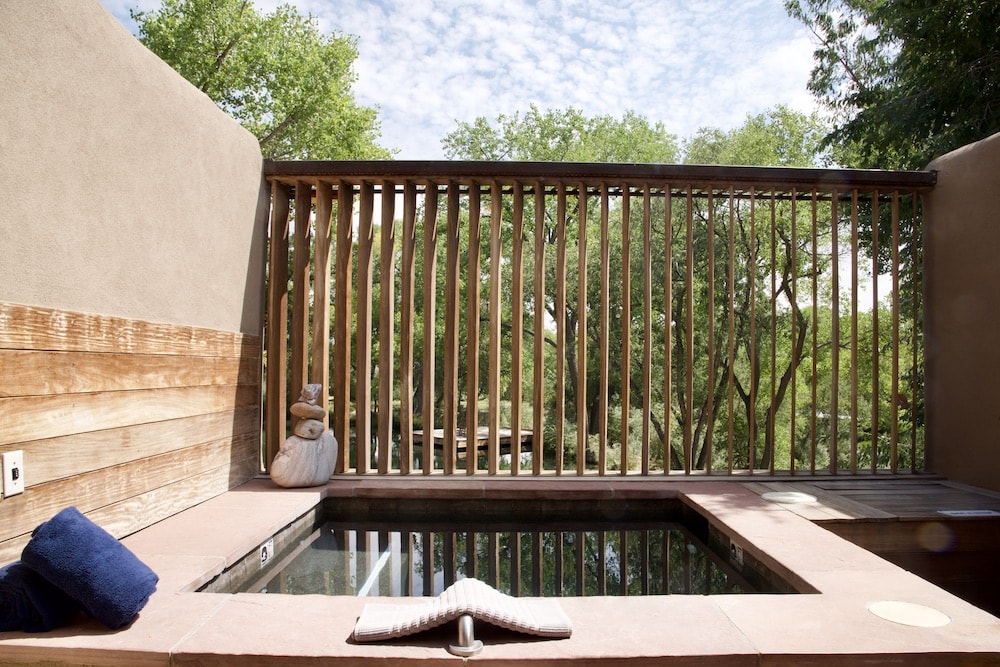
Rejuvenating Spa Escape at Ojo Santa Fe Resort
As we wrote in our behind-the-scenes preview, Ojo Santa Fe Wellness Resort is one of the best wellness resorts in America– and certainly the southwest. As Santa Fe’s only destination spa, this enchanting 70-acre oasis surrounds a natural springs sanctuary that has been a source of ancient wisdom and regional healing for centuries.
Visit the spa to experience a hot stone massage, a traditional Native American Blue Corn & Prickly Pear Salt Scrub, an East Indian-inspired head massage, a rejuvenating facial, reflexology, or reiki.
Regardless of what service you book, don’t leave without trying an Ojitos bath. This gorgeous open-air soaking experience takes place in a luxurious private outdoor tub before or after any spa treatment. (You can soak in groups or alone for as little as $30.)
Stay after your treatment to participate in any of the resort’s curated wellness experiences, from helping train service puppies to playing with cute silkie chickens. The resort also offers yoga, herbalism, and local agricultural classes, as well as consultations with any of the resort’s credentialed holistic wellness practitioners and doctors. (Including life coaching, couples therapy, and integrative medicine consultations.)
Overall, the insanely beautiful property is a haven for creating harmony between mental, emotional, physical, and spiritual wellbeing. Just be sure to book your experience ahead of time.
End the day at the on-site Blue Heron Restaurant, a gorgeous farm-to-table hot spot overlooking the expansive garden, lined with cottonwood and fruit trees that envelope a sacred medicine wheel. The property is particularly beautiful at golden hour. If you see it at sunset, you may never want to leave.
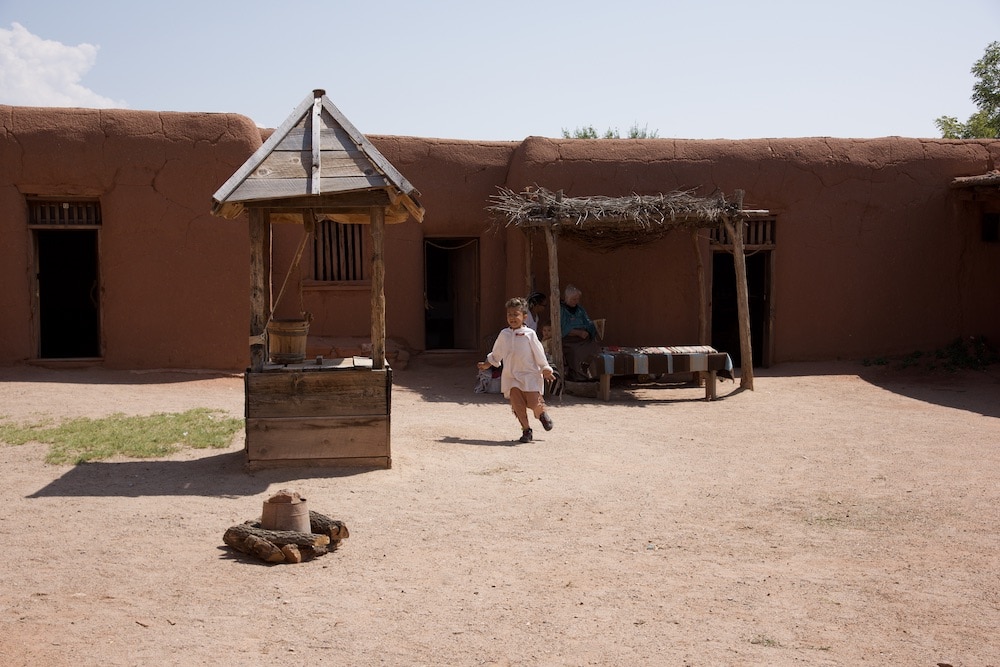
Go Back in Time at El Rancho de las Golondrinas
El Rancho de las Golondrinas is a 200-acre living history museum that showcases Spanish Colonial, Mexican American, and Native American heritage and culture from 18th and 19th century New Mexico.
The site features period-accurate details from the era, including old school “horno” bread ovens; wool-making and weaving demonstrations; live sheep wrangling; and pueblo interiors that showcase the tools and textures of the time.
The museum memorializes what was once an important paraje (“stopping place”) along El Camino Real. They also have a nice gift shop with locally-made artisanal products like whittled wooden spoons inlaid with real turquoise.
As the Southwest’s premier living history plantation, it’s sort of like New Mexico’s answer to Plymouth Plantation. It’s great for history buffs, technologists, families with small children, and people interested in learning more about traditional weaving and colcha embroidery.
-
Colcha Embroidery
Colcha embroidery is an intricate, regional style of needlework that was created in the Spanish colonies of Northern New Mexico. The word “colcha” translates to “bedcover”, which is the place where it is often displayed.
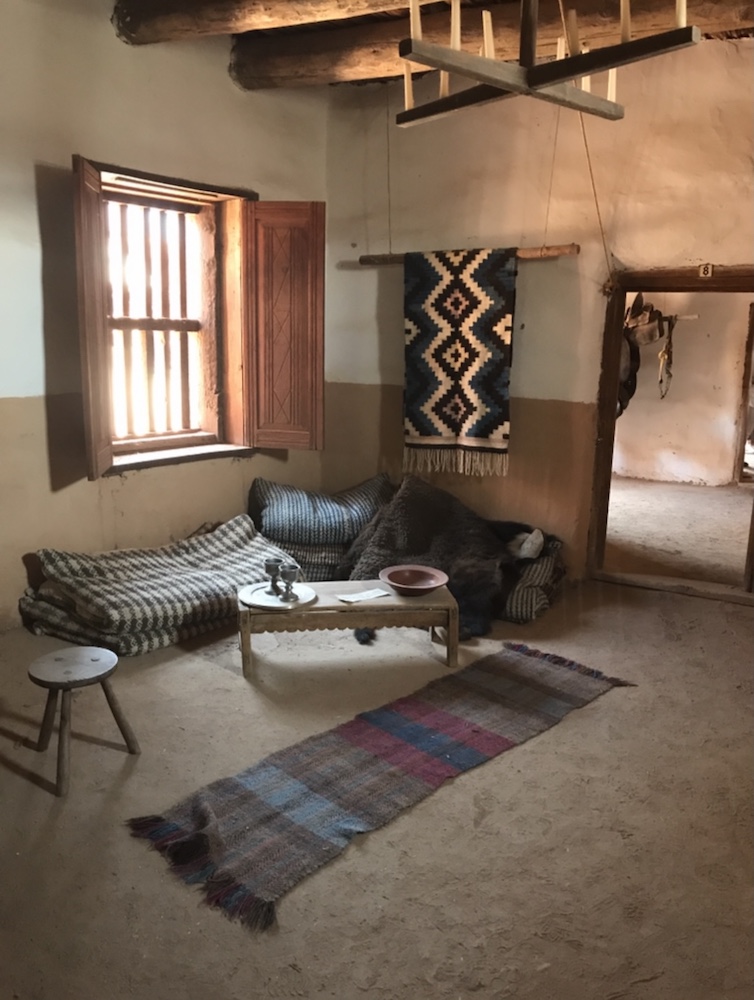
Here, you can take an intimate look at turn-of-the-century interiors and decor. These include kitchen tools, homemade furniture, and even baby bassinets. You can also get up close and personal with the sheep whose wool the homesteaders still use to make textiles to this day. Then, go watch them weave.
There’s also an on-site church with historic deity art and original adobe walls. Local period actors dressed in the styles of the times role-play chores throughout the museum. (Ask them if you have any questions about how things were done way back when. Even fetching water from the nearby dusty river used to be a half day’s task!)
Food and snacks are available for purchase on-site on the weekends. There’s also ample shaded seating for those who want to bring their own picnic. (Cool drinks recommended.)
Oh, and for those asking: “El Rancho de las Golondrinas” means “The Ranch of the Swallows”. You see a lot of those birds around these parts.

Shop For Amazing Pottery in Downtown Santa Fe
Andrea Fisher Fine Pottery sells amazing black and white pottery and local ceramics of all kinds. Plus, each item is clearly marked according to genre and maker. It’s a very educational experience.
While the aura can be a little stuffy (Andrea Fisher feels like a fine art gallery, and there will be reminders posted everywhere telling you not to touch anything) the products are nevertheless dazzling. If you love pottery and ceramics, make this your first stop in Santa Fe.
The gallery sells what is likely the finest collection of Southwest Native American pottery in the country. They even display pottery by famed local ceramicist Maria Martinez of the San Ildefonso Pueblo.
Adobe Gallery on Canyon Road, meanwhile, has lots of Acoma Pueblo pottery and other amazing, historic, Southwestern Pueblo pottery, as well as authentic Native American paintings.
For those who want to take a pottery class when visiting Santa Fe, I recommend Green River Pottery or Paseo Pottery. Book in advance!
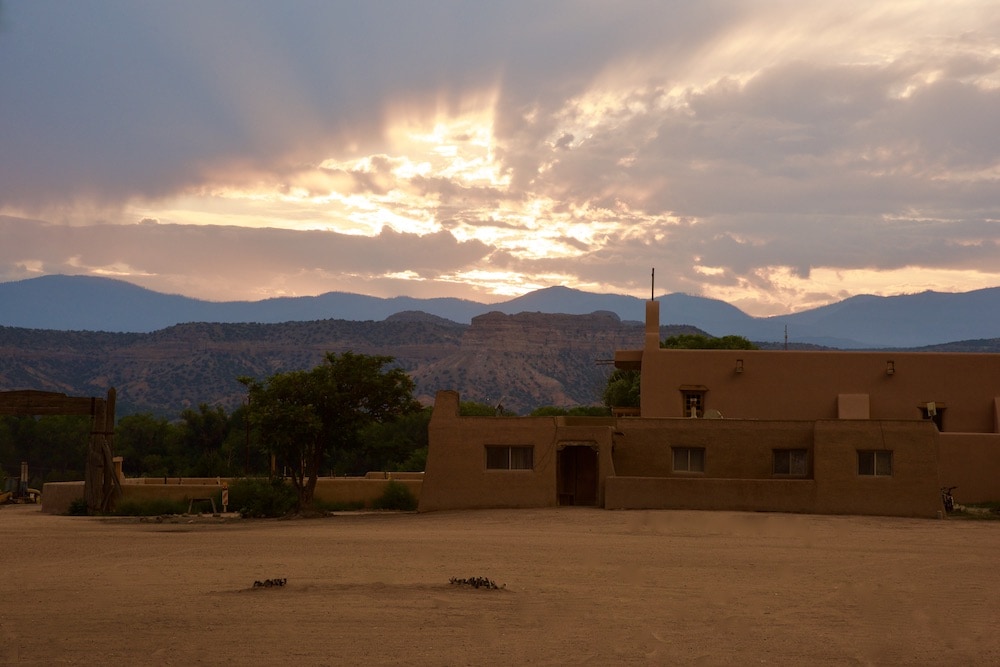
Visit Ohkay Owingeh / San Juan Pueblo
Visiting the San Juan Pueblo (Ohkay Owingeh) is a humbling experience that isn’t exactly structured– but it will offer you an authentic glimpse into current Native American living conditions in the American SouthWest.
At a welcome center near the pueblo entrance, you can pay $15 to enter the site with a camera. Then, feel free to wander around to the community center, the reservation school, and observe locals living their lives in and outside of their adobe homes. The community center here has archival photos of past and present local history as well as other educational materials on the tribe, who were famous hunter-gatherers known for their intricate black clay pottery.
Depending on the time of year and day that you visit, there may be more or less activity going on, so you’ll have to roll the dice.
You might arrive to the village on a day where a local ritual is being performed in the town square. There could be music, dancing, and local costume. Or, it might look like a sleepy, dusty ghost town, with nothing moving but the branches of the massive ancient cottonwood tree that towers above the town center. It all depends on the day.
One thing is clear, however, that the sunsets on the reservation are absolutely beautiful. (See above picture.)
If you have time (and he’s home), shop for local “Pottery by Kalavaza”. Ask the person at reception if visiting this potter’s home is an option during your visit.
To get inside any of the homes, you often have to know someone who knows someone, unless you strike up a conversation with a local. (But again, as they’ll advise you at the welcome center, it’s best not to pry.) Suffice it to say, Native Americans live modestly, so it’s often a very humbling experience.
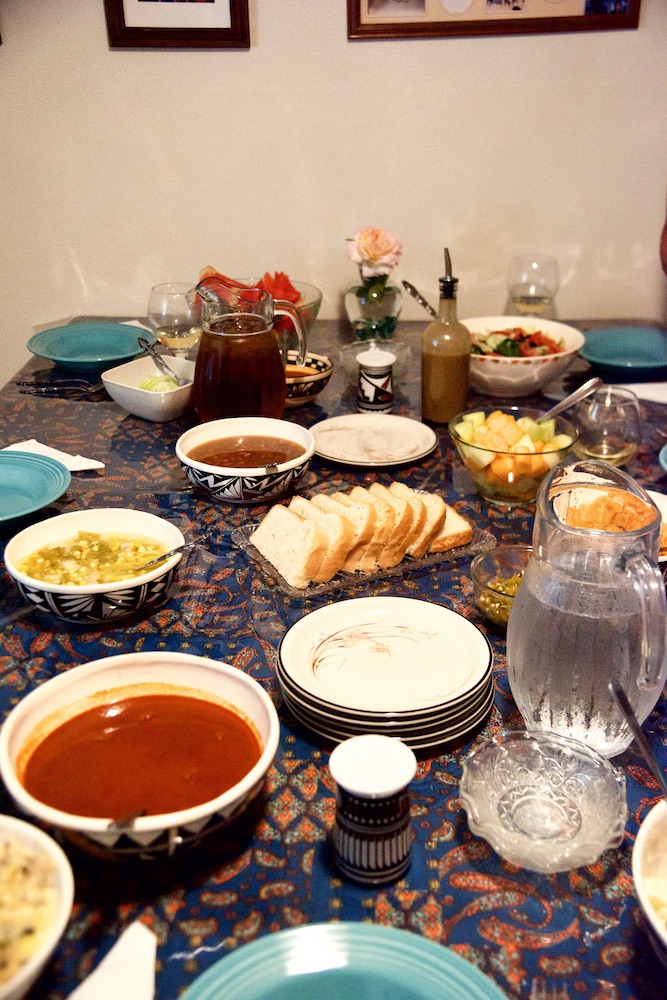
-
Insider Perspective
I was welcomed into a local family’s home once for dinner here– see a picture of the spread, above.
The meal included locally-foraged vegetables, tea brewed from wild herbs, homemade chili made with hunted game, and bread baked in a traditional Native American clay oven. There were also homemade raisin bars and butter cookies, among many other traditional and eclectic American fusion dishes.
This was followed by an intimate drum performance given by a local medicine man, who sang a Rain Song in the living room afterward. It was very special and cool!
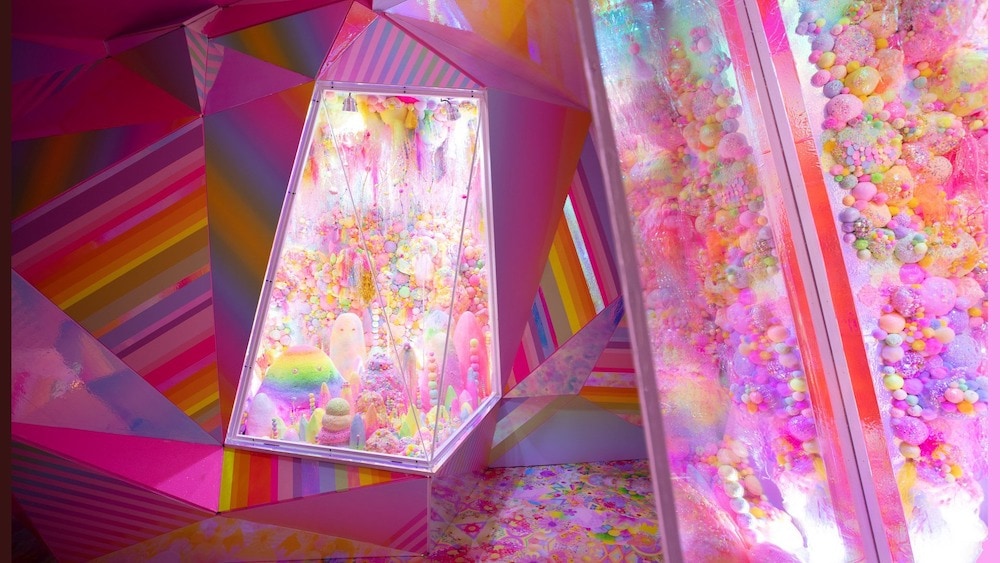
Explore The Meow Wolf Exhibit
At this art exhibit famously sponsored by Game of Thrones author George R. R. Martin, nothing is what it seems.
Inside the “House of Eternal Return”, refrigerators and closets become portholes into alternate realities. Meow Wolf Interactive Exhibit is a massive art space that’s basically like a Disneyland for artists, inclusive of weird, physical, interactive, living displays.
People come from all over the country to explore this wild and wacky art experience. Luckily, it’s fun even for people who haven’t seen the show. (Meow Wolf has nothing to do with the famed HBO series, but die-hard fans value the George R. R. Martin connection.)
Visitors walk through this museum almost like children going through a wonderland of their own imagination. (You enter the exhibit through a refrigerator, for example.) Ultimately, it’s strange and unorthodox, but wonderful– and a must-visit pilgrimage for GoT super fans.
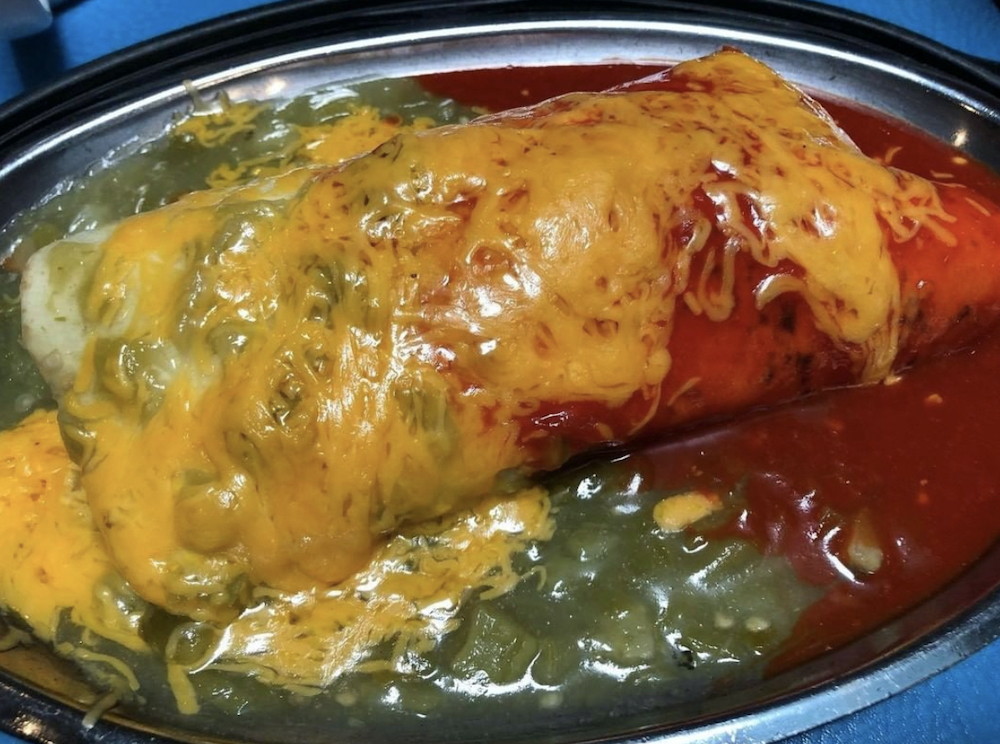
Get the Famous Breakfast Burrito at Tia Sophia’s
Tia Sophia’s is one of the most famous breakfast places in New Mexico. The southwest-style chile is famously hot, and the breakfast burrito is a big, hearty crowd-pleaser. Thus, you can expect crowds and a line unless you get there early (ideally before 9 AM).
Lore has it that back in the ’80s, longtime Tia Sophia’s waitress Martha Rotuno coined the phrase “Christmas”. This was the word used to describe the combination of red and green chile that most restaurants now offer as a topping on various New Mexican dishes. (More on this local slang, below.)
^ That’s a smothered “Christmas” burrito, above.
Overall, this is a reliably good breakfast joint that perfectly encapsulates the regional cuisine of Santa Fe. Expect light and fluffy corn tortillas, delightful huevos rancheros, and lots of chile. The portions here are also huge, so come hungry. You may even be able to split a burrito between multiple people!
For more top local restaurant recommendations, read our guide to the 12 Best Restaurants in Santa Fe. (<— There’s so much good food in the area, especially if you know where to look!)

Hike El Camino Real to La Cieneguilla Petroglyph Site
Hiking in Santa Fe can be very fun, rugged, and beautiful– but there are several safety measures to keep in mind. First, bring plenty of water and a brimmed hat– it gets hot out in the desert! Dress in layers if you can.
Secondly, don’t hike alone and always bring a fully-charged cell phone with you when you hike. Thirdly, if a path looks sketchy or untrodden, don’t take it; you don’t want to get lost.
That being said, hiking portions of the famous El Camino Real de Tierra Adentro route to the La Cieneguilla Petroglyph Site can be a really fun way to spend a morning.
This ancient rock art site is famous for the large number of hump-backed flute players (aka Kokopelli) and bird figures that can be found here. People of ancient civilizations carved them into the rocks here, where they remain a mysterious relic of the past. (This is actually the largest collection of glyphs in the American SouthWest.)
You’ll also pass beautiful basalt flats on this short hike off of the Paseo Real.
-
Insider Tip
For the best experience, go early– ideally no later than 7 AM. This way, you’ll beat the heat and have the best hiking conditions. Morning visits also ensure beautiful light and some serene solitude for your group.
For more information on this hike and other historic hikes in the area, go here. The trail is well-marked, and it’s one of the most accessible hikes in Santa Fe. (It’s flat, so even non-hikers can handle it.)
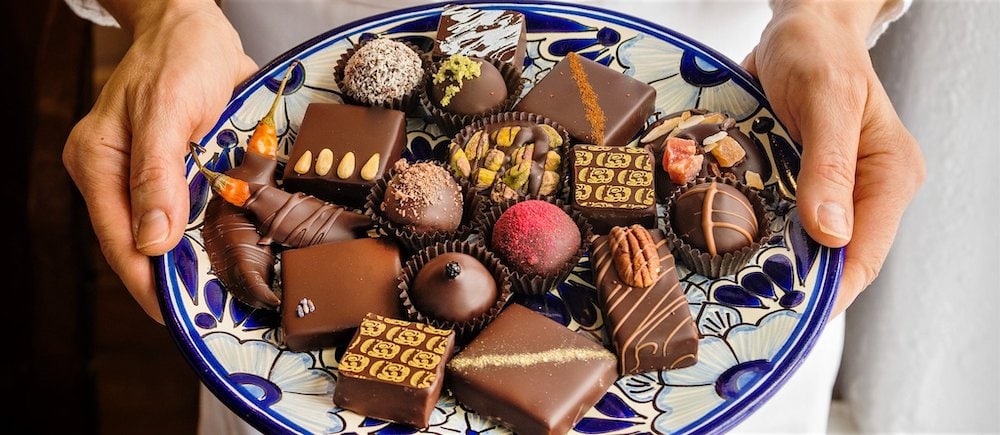
Try Historic Drinking Chocolate at Kakawa Chocolate House
Kakawa Chocolate House is easily the best chocolate shop in Sante Fe. Featuring a gorgeous, artisanal selection of historic drinking elixirs, incredible house-made ice creams, truffles, green-chili caramels, and other lovely boxed chocolate gifts, it’s a great place to shop for local souvenirs– and to sample some of New Mexico’s best sweets.
I love the Pre-Columbian and Mesoamerican chocolate elixirs at this fun little shop. These are a unique reflection of both regional culinary history and ancient tradition.
They also have classic Aztec and Mayan drinking chocolates. These are styles that you’re likely to encounter in other parts of the country, yes. But here, they reimagine the classics through a uniquely regional lens. (Drinking chocolate in Chicago is different than drinking chocolate in New Mexico, after all.)
Also, be sure to try the chocolate-covered peppers– but only if you like spicy-sweet! Also notable are the agave truffles (a rare find!) and the beautiful, always handmade bonbons. <— These come in unique regional flavors like Prickly Pear, Mescal, and Cherry-Chili. They’re all so unique!
Plus, the shop produces their chocolate in small batches with local agave syrup instead of cane sugar or corn syrup. This results in not only higher quality, somewhat “healthier” chocolate, but it also carries the unique terroir of New Mexico. ^ Just LOOK at those gorgeous truffles, up top! ^
Kakawa (pronounced ka-KA-wa) is an Olmec word that means cacao or chocolate. Here, the drinking chocolates on display represent historic recipes that span the time period 1000 BC to the mid-1900s AD.
In addition to traditional Pre-Columbian, Mesoamerican, Mayan and Aztec drinking chocolate elixirs, they offer 1600’s European drinking chocolate elixirs, Colonial American, and Colonial Mexican drinking chocolates. It’s fabulous!
Better still, the chocolatiers here support local, organic farmers. They also have dairy-free and vegan chocolates.
-
Insider Tip
Foodies shouldn’t leave this shop without trying Kakawa’s signature Goat Cheese & Sage truffle, a house favorite. (Trust me.) The local cherry-chocolate ice cream is also lovely in the summer.
I also cannot stress enough how unique the chocolate Chile D’Arbols are. These whole roasted New Mexico Arbol Chilis are dipped in agave caramel and finished in Kakawa’s 80% house-blend dark chocolate.
If you like chocolate with a kick, it’s an unforgettable experience bursting with local flavors!

Tour The Museum of International Folk Art + New Mexico Museum of Art
The Museum of International Folk Art and the New Mexico Museum of Art typically vie for the same crowd of tourists, but they are both worth going to if you’re interested in local history, art, and handicraft.
Whereas the Georgia O’Keeffe Museum is a must for pretty much any visitor to Santa Fe, these museums are geared towards those who really want to get into the weeds of local artisan culture. If you’re a hobby crafter or an artist yourself, this is the museum for you.
The Museum of International Folk Art features more than 100,000 objects from over 100 countries in a series of rooms dedicated to exploring different artistic genres. Each ultimately offers a unique, niche perspective on various folk art traditions.
The New Mexico Museum of Art, on the other hand, features more than 20,000 pieces from regional and iconic artists. They display the kind of art you’d also be likely to find that the Met in New York City or the Louvre. (In the past, they’ve had visiting exhibits featuring works by Michelangelo, for example.)
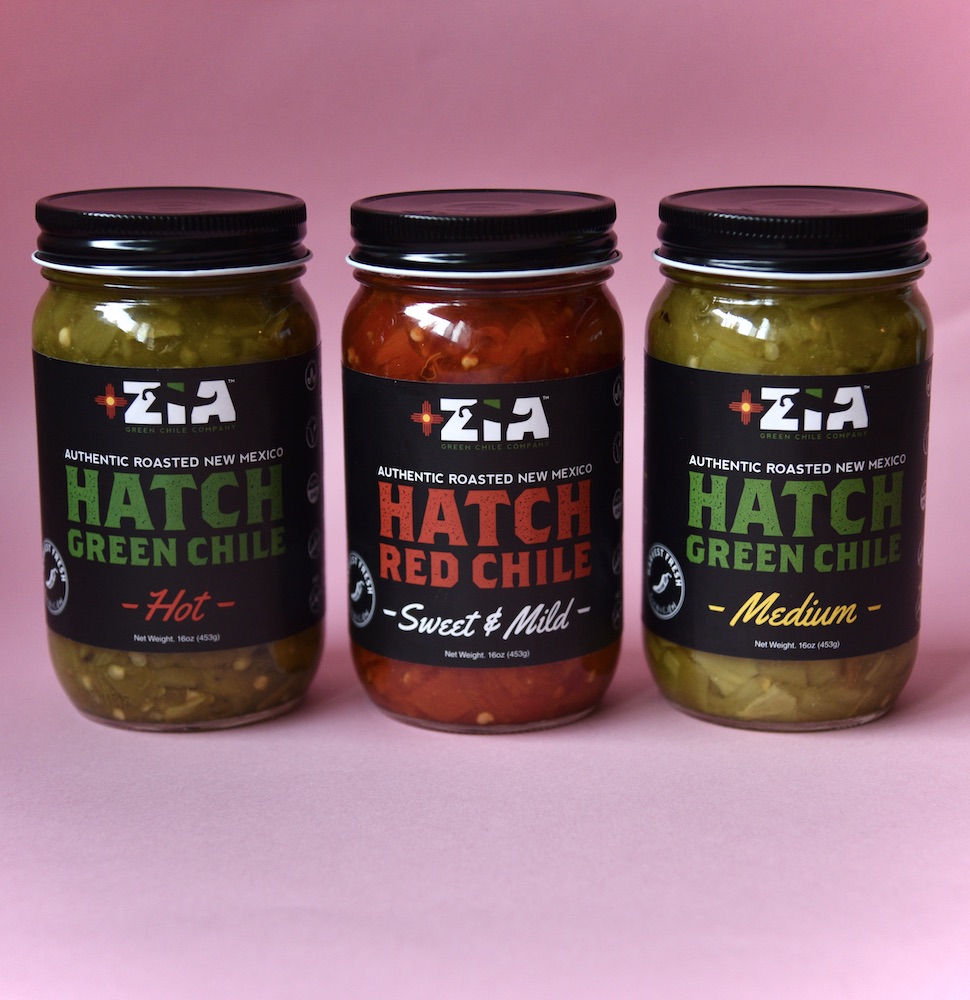
What To Buy in Santa Fe, New Mexico
A quick breakdown of local products and souvenirs to buy in Santa Fe.
-
- Turquoise jewelry (ideally from the Artist’s Walk!)
- Georgia O’Keeffe prints, photographs, postcards, and other paraphernalia (<— The gift shop at the Georgia O’Keeffe Museum is best for this.)
- Piñon incense
- Native American textiles + rugs
- Locally-made pottery
- Latino art
- “Biscochitos” and/or pine nut cookies (ideally at the Santa Fe Farmers Market!)
- Pinones, aka local pine nuts
- Hatch chili products (seasonal)
- Blue corn pancake mix (<— I love the Blue Corn Pancake Mix by Santa Fe Culinaria. It’s the best!)
- Bronze statuary if you’re an art collector (<– Go to Canyon Road for this.)
- Locally-made lavender products
- Locally-woven baskets
- Southwest-style chocolates (Kakawa Chocolate House– detailed above– makes lovely agave caramels, piñon caramels, and red + green chili-infused chocolates, etc)
- A copy of the book, Death Comes for The Archbishop by Willa Cather– which is famously set in Santa Fe. (Look for it at Collected Works Bookstore & Coffeehouse!)
- If you go on a hike, it’s also fun to collect a single set of cottonwood leaves, piñon pine needles, and/or juniper fronds to dry between the pages of a book. These are quintessential plants of Northern New Mexico, and when you get home, you can frame them. (Plus, they’re free! Just be respectful of nature and only take what can fit in the palm of your hand.)

Shop Local Turquoise From Native American Vendors at the Palace of the Governors
In historic downtown Santa Fe, shop the Artist’s Walk outside the Palace of the Governors for artisan turquoise jewelry, silver products, and other small locally-made treasures.
The artists who exhibit work on blankets under the shade of the four-century-old portal arches are local Native Americans (typically of the Navajo Tribe) and their relatives. Be careful with their work if you pick it up to inspect. And don’t be afraid to ask questions!
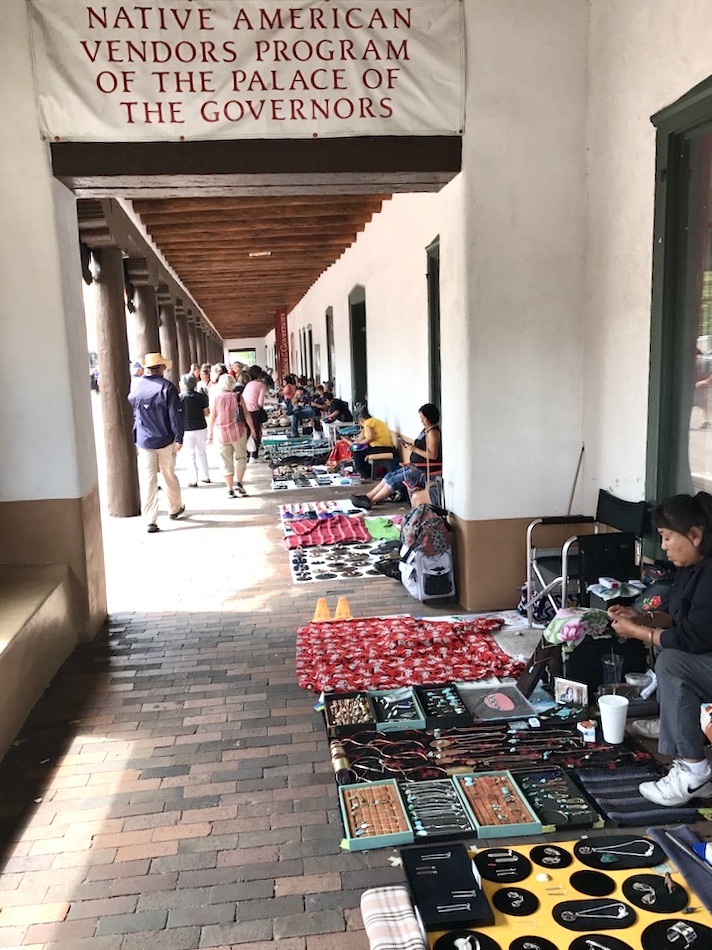
Haggling, of course, is permitted but will often only get you so far. When you buy here, your money directly supports local indigenous artists and the community. (Unlike some of the boutique jewelry shops nearby, who may take a steep cut out of your purchase.)
Fortunately, as a result, you don’t have to worry whether or not your turquoise is authentic. This vendor’s program is tightly regulated and has been so for over six decades.
You’ll get a certificate of authenticity with every piece you buy. (See the below example.)
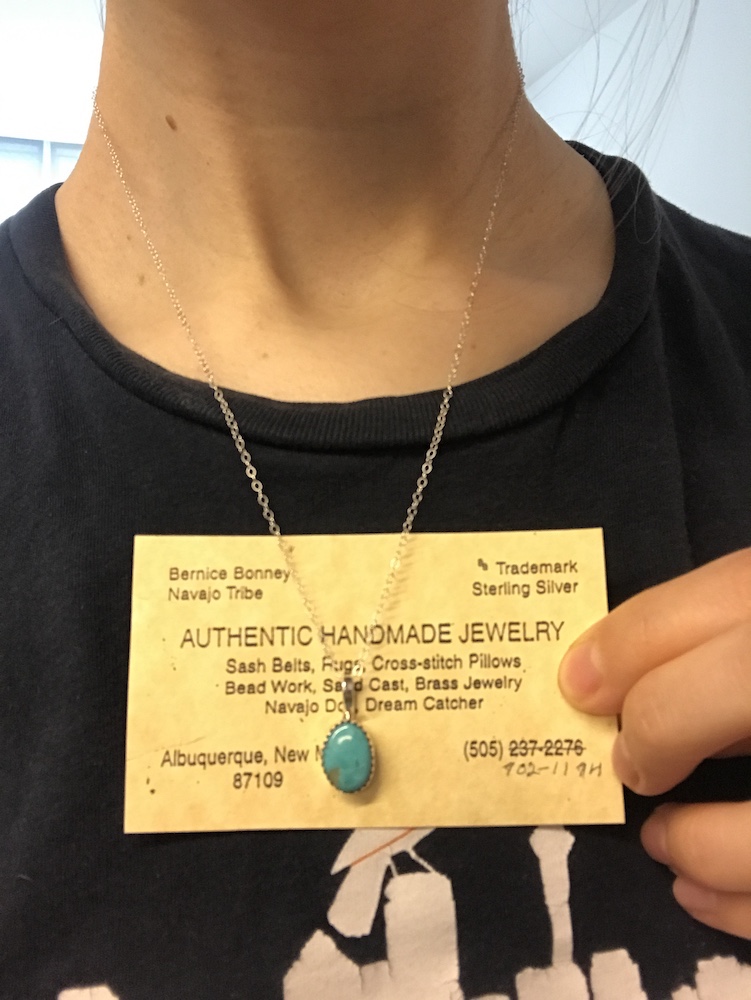
-
Authenticity and Fairness
A daily lottery also ensures that a rotating selection of artisans from various pueblos around New Mexico have a chance to display their work. So, there’s always something new to see.
As a result, this is THE place to shop for authentic turquoise jewelry and silver products in Santa Fe. Every item is the product of true Native American heritage and craftsmanship.
It’s very cool!

Shop The Santa Fe Farmers’ Market (Saturdays 8 AM to 1 PM)
The Santa Fe Farmers’ Market is a great place to buy blue corn products, biscochitos, fresh pinones, prickly pear products, local chile, and other great regional produce, meat, dairy, eggs, traditional dried foods, flowers + house plants, and fresh baked goods.
The market takes place year-round on Saturday mornings from 8 AM to 1 PM. The address is 1607 Paseo de Peralta at S. Guadalupe Street. GPS can direct you.
Go here to interact with the community and shop like a local. There’s frequently live music, as well as select artisan crafts and delicious hot food for purchase. (Think: tamales, kimchi pancakes, local lavender donuts, and more!)
There are also plenty of bike racks for pedestrians. Otherwise, there’s on-street metered parking and covered parking at the Railyard Parking Garage. (It has walking exits near REI and the Violet Crown Cinema.)

Shop Native American Textiles at Santa Fe Trading Post
Some of the coolest, most regionally significant items to buy in Santa Fe are traditional Native American or Spanish Colonial textile products. Just be wary of cheap imitations at souvenir shops around the city.
If it doesn’t say where it’s made, for example, you should ask the store clerk. Otherwise, you might end up with an “authentic” Santa Fe-style tablecloth made in… Guatemala.
To that end, Santa Fe Trading Post has a lovely collection of real Native American, Anglo, and Mexican textiles. They also sell pottery and other Native American and Southwestern goods.
Don’t be fooled by their lack of Internet presence. This shop is the real deal, and it’s a trusted place to buy.
Also: don’t be afraid to bargain for better prices than those marked! Sadly, less scrupulous salespeople may jack up the pricing if they sense your enthusiasm for a particular item. This is worth remembering when shopping anywhere in Santa Fe where the items are not priced.
Either way, I love the long table runners at this cramped, detail-filled shop. They’re pricy but super beautiful!
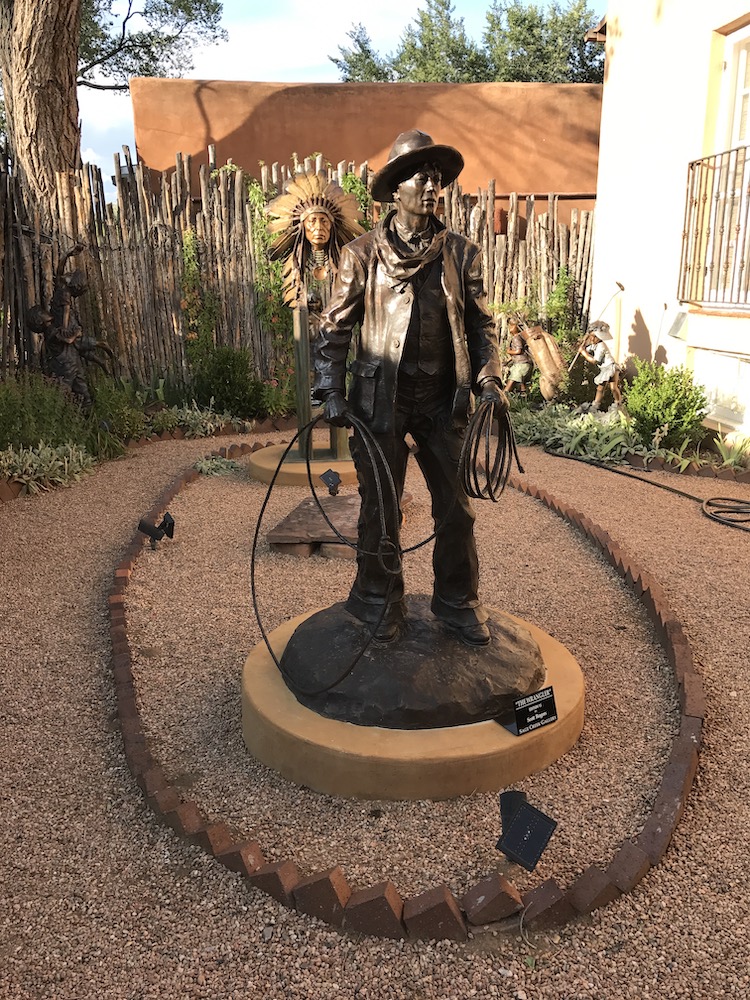
Go Art-Hopping on Canyon Road
Canyon Road in Santa Fe is a world-renown destination for art lovers, who flock to this winding, walkable street in Santa Fe for the same reasons one might hit up Rodeo Drive in Los Angeles, or Art Basel in Miami.
Known for its many art galleries and ubiquitous bronze statues, Canyon Road is THE place to shop and explore the best sculpture, painting, and original contemporary and fine art that New Mexico has to offer.
Even if you don’t buy anything– and many people don’t– it’s worth the visit just to get a sense of the rare Indian antiques and Santa Fe School designs on display.
All of the art is regionally inspired and locally made.
There are also several notable restaurants and shops spread between all the galleries on Canyon Road, which used to be a footpath used by Pueblo Indians. You’ll be so besotted by the beautiful bronze statues and impressive contemporary art everywhere that you’ll feel like the street itself is a 3D gallery. (And with over 90 galleries located on Canyon Road, alone, it basically is.)
-
Insider Tip
Art and design lovers should leave plenty of time to explore. Even if you’re not buying (a $3,000 bronze sculpture of a Native American woman IS pretty expensive, after all), you’ll still have plenty to look at.
Stop by El Farol for dinner afterward and for the full experience. It’s a great way to spend an afternoon!

Sample “Christmas” Chile
When ordering chile at restaurants in and around Santa Fe, you may be presented with the option for “red chile, green chile, or Christmas” sauce. “Christmas” is shorthand for a mix of both red and green chile sauces, as served on an enchilada, for example.
Where possible, I always recommend going with the “Christmas” option, that way you’ll get to taste both regional flavors. It isn’t a true Santa Fe experience if you don’t try chile at least once.
Related: The 12 Best Restaurants in Santa Fe for Unforgettable Meals.

Sip Prickly Pear Margaritas on the Santa Fe Margarita Trail
As we wrote in our guide to the 12 Best Restaurants in Santa Fe, the Coyote Cafe & Cantina serves some of the best margaritas in Santa Fe– which is saying a lot, as this is a city that’s famous for its margaritas.
Here, try the fantastic prickly pear margarita, which offers a literal taste of New Mexico. (Prickly pear grows everywhere in these parts.)
With its perch above Santa Fe Plaza, Coyote Cafe is also one of the best locations for instant cultural immersion in Santa Fe. Note, for example, the cool graffiti-style murals adorning the walls, and the number of locals livening up the bar. It’s quite the scene.
Drinking margaritas, moreover, is a rite of passage for cocktail lovers visiting Santa Fe.
FWIW, we also love the margaritas at Maria’s New Mexican Kitchen, the Signature House Margarita at Del Charro Saloon (it pairs beautifully with their burger!), and the Smoke & Fire Marg at La Choza.
^ If none of these strike your fancy, then there’s no help for you. 🙂
Try Frito Pie at the Five & Dime General Store (If You Dare)
Santa Fe’s “original” Frito Pie can be found at the Five & Dime General Store— and yes, Frito pie is exactly what it sounds like. It consists of Day-Glo orange nacho cheese and layers of beef chili spooned directly into a bag of Fritos. You eat it with a spoon, crunch and all.
Ultimately, this is a Santa Fe original food– so famous that even Anthony Bourdain had to try it (see the video, above).
It’s not exactly a thrill for foodies, but those looking to experience some good old-fashioned quirk that can only be found in the SouthWest, this is a great novelty food to try just for the experience.
And honestly, many people love it.

Peruse “Soul-Stirring” Works at Patina Gallery
Located in historic downtown Santa Fe at a walkable distance from the Georgia O’Keeffe museum, Patina Gallery showcases “soul-stirring” contemporary jewelry, fine art, and intriguing functional design objects, which is why it is often described as “Santa Fe’s most beautiful gallery.”
The refined space is, in a word, lovely for those in the market for world-class creative jewelry– or even those who just want to see it.
Here, owners Allison and Ivan Barnett have curated works from over 100 renowned American and European artists. Their central focus is to showcase compelling, creative stories through art. This fine jewelry, but I view going here as more of a gallery experience. There’s no pressure to buy– just observe and enjoy!
Fashion and design lovers should keep an eye out for Claire Kahn’s incredible “woven” glass bead rope necklaces. These combine both sensory design and mixed medium art into beautiful, wearable pieces.

Other Things to Consider When Visiting Santa Fe, New Mexico
- Remember: Santa Fe is in the desert. The air in Santa Fe is therefore so dry that you very well may have to ask for a humidifier at your hotel. Don’t be shy– they get this all the time! (Or at least the top resorts like Ojo Santa Fe do.) If you’re staying at an Air BnB, check to see if they have air conditioning before booking.
- ^ On a related note, be sure to drink plenty of water, even if you don’t feel warm or overheated. Dehydration can sneak up on you fast in these parts. Ultimately, whether it’s winter, spring, summer, or fall, the desert enveloping Santa Fe is always very DRY. It will suck the moisture right out of you! Plan accordingly.
- Iconik Coffee Roasters’ cafe on Lena Street is the most lovely coffee shop in town. Check it out!
- The sun is also very intense, always. As I mentioned above, be sure to bring sunglasses, sunscreen, and a hat, no matter what the season. I also recommend UPF+ sun protection clothing if you plan on going on a long hike. (There isn’t much shade in the surrounding desert landscape.)
- Uber and Lyft are both available in the city and can be very helpful for those traveling without a car. Routes Bicycle Tours also offers bike rentals & tours for those who want to explore on two wheels.
- Finally, the desert outside of Santa Fe is one of the few places left in the world where you can get a truly uninhibited view of the stars at night. (There’s very little light pollution.) Photographers, bring a tripod and your A-game!
***
Related: The 12 Best Restaurants in Santa Fe for Unforgettable Local Meals.
Take a Behind-The-Scenes Look at Ojo Sante Fe– New Mexico’s Premiere Wellness Resort.
Do you have any recommendations on where to stay, close to the plaza old town?
It depends on your budget but La Fonda is generally well-loved by visitors and has a great sense of place– it’s a lovely place to stay in Santa Fe as its a historic property located right on the Plaza, too.